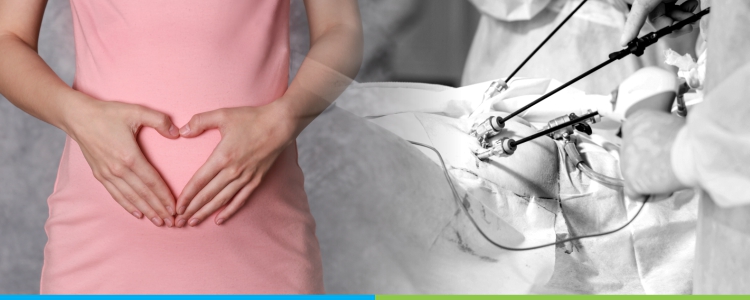Everything you need to know about Laparoscopic Surgery

Laparoscopic surgery
Laparoscopy surgery is a ‘minimally invasive surgery’ which incurs small incisions, usually not more than ½ inch. It uses a long and slender device called a laparoscope which is inserted into the abdomen through a small incision. A camera attached to it allows the obstetrician–gynaecologist (ob-gyn) to view the abdominal and pelvic organs on an electronic screen. If a problem needs to be fixed, other instruments can also be used. These instruments are usually inserted through additional small incisions into the abdomen. It is essentially a painless, scarless surgery.
What are the benefits of laparoscopy?
The beauty of laparoscopic surgery is the recovery time which is very short, most of the time it is a day procedure meaning the patient arrives in the morning gets the surgery done and goes back home in the evening, unlike open surgeries where the patient is hospitalized for a longer duration. In case of major surgeries which are performed laparoscopically, patient recovery might take a few days.
- Due to the magnification of the structures visualized, surgery can be very precise without much tissue damage.
- Lesser pain is experienced after laparoscopic surgery than after open abdominal surgery, which involves larger incisions, longer hospital stays, and longer recovery times.
- Recovery from laparoscopic surgery is faster than recovery from open abdominal surgery owing to the small incisions. The smaller incisions in laparoscopy allow you to heal faster and have smaller scars.
- Since the incisions are very small, the risk of infection is lower than in open surgery.
- Multiple procedures can be performed at the same time for the patient for example if the patient requires appendicectomy and has an ovarian cyst, both can be managed at the same time with the same small incisions. This is possible because of the access we have to the whole abdomen through a laparoscope.
Results of laparoscopic surgery are far more superior than open surgeries in terms of patient safety, the precision of surgery, hospital stay, recovery time and patient comfort and pain scores.
What are the complications in laparoscopy?
Laparoscopy can, however, take longer to perform than open surgery. The longer time under anaesthesia may increase the risk of complications. Sometimes complications do not surface right away but come forth a few days or a few weeks after surgery. The difficulties that laparoscopic surgeries can include are:
- Bleeding or a hernia at the incision sites
- Internal bleeding
- Infection
- Damage to a blood vessel or other organs, such as the stomach, bowel, bladder or ureters.
But eventually, any surgical complication depends on the skill of the surgeon which in turn depends on the training and experience of the surgeon. Most of the complications can occur in open surgery also and these complications are not unique to laparoscopy. The complications can be managed by the laparoscopic method itself.
When is laparoscopy used?
Laparoscopy is used to investigate the cause of chronic pelvic pain, infertility, or a pelvic mass. If a problem is detected during the process of laparoscopy, it often can be treated during the same surgery. The following medical conditions can be diagnosed and treated using laparoscopy:
- Endometriosis: If medications have not helped endometriosis, a laparoscopy may be recommended by the doctor. A laparoscope is inserted inside your pelvis to investigate, and if an endometriosis tissue is found, it is removed during the same procedure.
- Fibroids: Fibroids are abnormal growths that form inside or outside the uterus. Most fibroids are benign (not cancerous), but a very small number are malignant (cancerous). Fibroids can lead to pain or heavy bleeding and laparoscopy can be used to remove them.
- Ovarian cyst: Some women have a tendency of growing a fluid-filled sac called cysts on their ovaries. The cysts often go away without treatment. But if they do not, your ob-gyn may suggest that they are removed with laparoscopy.
- Ectopic pregnancy: An ectopic pregnancy is when the embryo gets attached outside the uterus. A laparoscopic procedure may be used to remove an ectopic pregnancy.
- Pelvic floor disorders: Urinary incontinence and pelvic organ prolapse can be treated by laparoscopic surgery.
- Cancer: Cancer tumours can be removed using laparoscopy.
Essentially most of the conditions which require surgery in Gynaecology can be done laparoscopically. In case of any of the following symptoms, visit your doctor immediately:
- Fever
- Severe pain that gets worse
- Heavy vaginal bleeding
- Redness, swelling, or discharge from the incision
- Fainting
- Inability to empty your bladder
Dr M N V Pallavi speaks about her experiences with laparoscopic surgeries
“For me preparing for laparoscopic surgery for that matter any surgery is like performing a puja. We prepare for a puja with utmost dedication and concentration each and every time, I have a similar approach towards surgery as I would want the best outcome for each and every one of my patients. Thorough workup of the patient without missing any detail, discussing in detail with the patient and their family about the procedure intended and possible outcomes, and answering all their queries form a major part of my preparation.
Performing the surgery becomes like clockwork once all these things are in place, because of the experience of performing a number of surgeries. Of course, I always yearn to give the best to my patients so I strive to keep
myself updated about all the latest advancements and pass on the benefit to my patients. One more most important aspect of laparoscopic surgery is that it is completely about teamwork amongst well-trained assistants, theatre staff and the doctor. I am glad that over a period of these five years in OMNI, we have been able to develop a wonderful camaraderie with my team.
Working as a laparoscopic surgeon for the past ten years I would have probably done more than a thousand surgeries ranging from simple diagnostic laparoscopy to laparoscopic tubectomies, lap ectopic resections, lap ovarian cystectomies, laparoscopic hysterectomies, laparoscopic myomectomies, etc. Every case is an interesting learning experience and the experiences keep us humbled all through.
Though I am a surgeon at heart, one of my most memorable cases is managing an ectopic. Medically, she was advised surgery by the doctors she consulted prior to visiting us, we managed her medically and she came back pregnant the next year and delivered with us. I strongly believe that surgeons more than learning how to do the surgery should know when to operate and when not to operate. To exert this discretion is of utmost importance in my opinion.
High-risk cases are extremely challenging to handle especially in obstetrics because we deal with two lives, the mother and the baby. To manage these cases. apart from strong academic and scientific knowledge, decision making at the appropriate time is vital as there is a very thin line between saving both the baby and mother and losing them. Sometimes we have to take a decision to lose the baby for mother’s sake through a painful decision. Handling these cases is extremely stressful as pregnancy is always a happy event which is looked forward to and things turning bad during pregnancy are not taken well by the family, so taking care of these volatile patients as well as their family takes quite a toll on us. But at the end of it when the patient recovers there can be no happier moment, and so we go on.”

Dr M N V Pallavi
Chief Gynaecologist, Dept of Gynaecology
Giggles by Omni RK Hospital
Visakhapatnam
